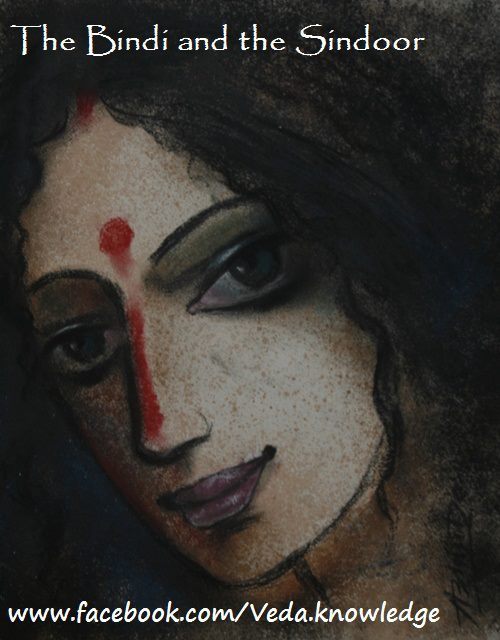The Bindi and the Sindoor:
Sindoor (सिन्दूर) is a traditional red or orange-red colored cosmetic powder from India, usually worn by married women along the parting of their hair. Usage of sindoor denotes that a woman is married in many Hindu communities, and ceasing to wear it usually implies widowhood.
Bindi originally is a round mark on the foreheads of Hindu females. Bindi is derived from the Sanskrit word bindu meaning dot or drop. Making a mark on the forehead is a very old tradition among Hindu men and women. The old name for this mark is tilaka. Tilaka is made with coloured earth, ashes of yajna (the fire offering), sandalwood paste or unguent. The term tika or tikka is a distorted form of the term tilaka.
According to the Legends, Radha the consort of Lord Krishna turned the kumkum into a flame- like design on her forehead. In the famous epic Mahabharata, Draupadi the wife of the Pandavas wipes off her sindoor in disgust and despair at the happenings in Hastinapur. It is also found in Sanskrit plays of Kalidasa and other works like Panchatantra or Kathasarita Sagara. Tulsidas mentions it in his Ram Charit Manas at the time of the marriage between Ram and Sita. Use of Sindoor is very widely mentioned in The Puranas Lalitha Sahasranama and Soundarya Lahari. Adi
Shankaracharya writes in Soundarya Lahari:
“Tanothu kshemam nas tava vadhana-saundarya lahari. Parivaha-sthrotah-saraniriva seemantha-saranih. Vahanti sinduram prabala-kabari-bhara-thimira-. Dvisham brindair bandi-krtham iva navin’arka kiranam.”
(Oh mother, let the line parting thine hairs, which looks like a canal, through which the rushing waves of your beauty ebbs, and which on both sides imprisons, your Vermillion, which is like a rising sun, by using your hair which is dark like the platoon of soldiers of the enemy, protect us and give us peace.)
Significance:
~ The positioning of the bindi in between the eyes is significant. According to the Indian sages, the area between the eyebrows is the seat of latent wisdom. This point between the eyes, known by various names such as Ajna Chakra, Spiritual Eye, and Third Eye, is said to be the major nerve center in the human body. In the Kundalini yoga and Tantric tradition during meditation, the “kundalini” - the latent energy that lies at the base of the spine is awakened and rises to the point of sahasrara (7th chakra) situated in the head or brain. The central point, the bindu, becomes therefore a possible outlet for this potent energy.
~ The red colour is connected with rajas, one of the three constituents of prakriti (nature) that is sattva, rajas and tamas. These three constituents of prakriti represent goodness, passion and darkness. Each of these is represented by a colour. White colour is for goodness, red is for passion and black is for darkness and ignorance. These three constituents of prakriti are described in Sankhya philosophy of Hindu religion. The red colour of bindi or sindoor represents the passionate aspect of prakriti. The red implies also love, fertility and strength. Sindoor (vermilion) is sublimed mercuric sulfide and is a brilliant red pigment.
~ Significantly when an Indian woman has the misfortune of becoming a widow she has to stop wearing this mark. The sindoor, apart from being an auspicious adornment, also plays the role of a silent communicator. If there is a death in the family, women don’t wear sindoor. During menstruation, some women refrain from wearing sindoor.
~ Some scholars associate the bindi with the birth of Kali from Durga’s forehead. It is supposed to signify the mystic third eye of a person. It is applied on the forehead on all religious and ceremonial occasions and means welcome.
In the 19th century, Sufi leader Sharafuddin Maneri encouraged Muslim women to apply sindoor in Bangladesh. This was severely condemned by reformist movements. In today’s world not only the Hindu damsels use bindi but it also found its way to the homes of Buddhists, Jains, Muslims, Christians and many others. (Source: http://www.facebook.com/Veda.knowledge)
I decided to share this article from my favorite Hindu site on facebook because the issue of the wearing of the bindi has come up time and again on sites I use such as Tumblr. I see many young Indian women outraged that Western white youth are wearing the bindi as rather a fashion trend. While I can certainly understand their feelings on the matter I myself feel that it is really a non-issue. Many religious symbols have been used throughout history by those who have no understanding of its significance, and while I do believe it is a sad thing to see, it is what it is. The use of the bindi as a fashion trend does not in any way detract from its sanctity among those to whom it is sacred.
I do on the other hand feel it important to educate those who have no understanding of its true meaning and purpose. It is not just a spiritual symbol, but is a religious one as well...I find it rather ironic that those who feel it 'cool' to wear the bindi are usually outspoken against religion.
Om Shanti,
Nirvani

Blogs can generate revenue through advertising, sponsored content, or partnerships with brands. Things To View While Using Free Internet Articles may also be monetized, but traditional publishing models, such as subscriptions or ad revenue sharing, are more common.
ReplyDeleteWearing the bindi is a captivating tradition that holds deep cultural significance. It's a symbol of heritage, spirituality, and identity. This vibrant adornment gracing the forehead carries a legacy of beauty and meaning. The bindi connects us to the rich tapestry of cultural practices that have been passed down through generations. Should I Eliminate Video Games From My LifeIt's inspiring to witness how this tradition continues to thrive and evolve, representing a beautiful fusion of tradition and modernity
ReplyDelete